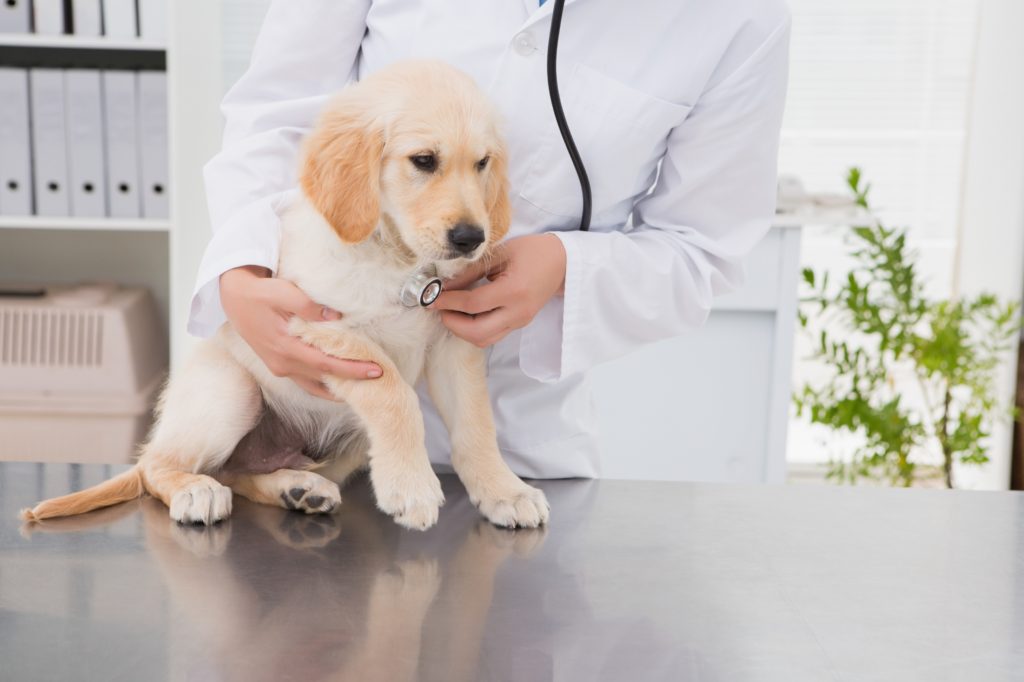I remember getting a ‘Thank you’ card from a client with a lovely picture on the front, of a lurcher in a car looking out of the window. Underneath it says, ‘Park, not vets. Park, not vets.’ It’s a cute card, but as a vet and behaviourist it also makes me a bit sad that the patients we care for don’t care for us!
If you are lucky enough to be taking a puppy for its first trip to the vet you can lay the foundations for a lifetime of low-stress visits. Start by ensuring the journey to the vet is as nice as possible. Your puppy may be happiest if held by someone on the back seat, but make sure the puppy can’t get free and distract the driver or become a missile in an accident. Many puppies are happier secured in a cat carrier for their first few car trips. Don’t feed just before travel, and drive gently to reduce the chance of travel sickness. Give yourself plenty of time to get to the vet and find a parking space, but if you are very early perhaps check-in, then wait in your car rather than in a busy waiting room. Bring some very tasty treats to offer the puppy while the vet does their examination; something cut up small and easily digested is best (perhaps some cooked chicken). If you are lucky your puppy won’t even notice the vet giving the vaccinations (apart from the Kennel Cough which is given as a drop into the nostril).

A vaccination course will involve two or three trips to the vet in a short time. Thereafter, you might not need to see the vet until neutering or the first health check and ‘booster’ at a year old. However, I recommend regular visits for puppies; either to build on the good early experiences they have had or to counteract any negative ones. Most practices will be more than happy for you to bring your puppy in for regular weight checks, and they may even offer adolescent health checks with a nurse. At home, you should practice handling your puppy in the way that a vet might need to. I tell my puppies what bit I am going to look at and repeat this in the clinic if I, or someone else is examining them (for example I say ‘eyes’ before an eye examination). You should be able to touch every part of your pup’s body while he stays relaxed and happy, and waits for a treat or toy as a reward! You may even want to train your puppy to wear a muzzle, just in case one is ever needed. Unfortunately, muzzles are often only put on for the first time when a dog is frightened and in pain which makes them more difficult to use in the future.
If you have an adult dog who has no issues with the vet, you can support and prepare in much the same way as for a puppy. It is a good idea, even with a well-behaved adult dog, to practice ‘vet handling’ in between vet visits so that your dog remains calm and confident. One area where I often see dogs become distressed is when they need to be picked up and placed on a consultation table. Medium to large dogs may not be used to being picked up and can panic when their feet come off the floor. They also appear uneasy when on the table; probably as this is not a place they would be encouraged to be at home! Practice lifting your dog at home, and consider bringing a familiar mat to put on the consulting table to make them feel more relaxed.
The most difficult dogs in the clinic are those who have already developed a fear of vet visits. For these dogs, we start on a programme of desensitisation and counter conditioning at the clinic as well as working on ‘vet handling’ at home. It can take many months, and a lot of high value food or play rewards, for a dog to feel confident in the clinic. Difficulties will arise if the dog needs an urgent vet visit during training. Depending on how afraid the dog is and how far through training, the owner, vet, and behaviourist should be able to work out a plan which minimises the effect of the visit on the dog. This may be as simple as the vet examining the dog at home, in the car, or the waiting room. Always advise the clinic that your dog might need an extended appointment, and ask if there is a quiet time of day so that nobody feels rushed. For more severe cases medication may be suggested, either before you bring the dog to the clinic, or given at the clinic to allow a safe examination. Some medications will impair the dog’s ability to remember a less pleasant visit. A very difficult decision for owners can be whether to stay with their dog during veterinary procedures or not. Some owners are very helpful and can calm and reassure their pet, but those who are very stressed themselves can make their dogs feel more anxious. In some circumstances, such as when a dog is hospitalised, it is not possible for owners to stay. Build a great relationship with your practice so that you know your dog will be in good hands.

